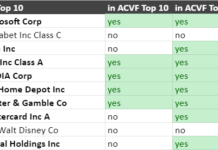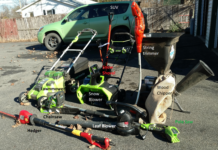Tom Konrad, CFA
I included the Powershares Global Progressive Transport Portfolio (PTRP) as an investment option instead of three stocks in my Ten Clean Energy Stocks for 2010, as part of a simplified portfolio for small investors wanting to minimize costs by making fewer trades. The other Exchange Traded Fund I used in this way was the First Trust Nasdaq Clean Edge Smart Grid Infrastructure Index Fund (GRID). I took a look at the holdings of the Smart Grid ETF here, and they are not exactly what you would expect from the name. Since it makes sense to know what you’re buying, I decided to do the same for PTRP.
The left side of the chart below shows my classification of the companies held by PTRP (as of the end of 2009). Some companies fell into multiple categories, so I divided their industry allocation accordingly. The right side shows a similar treatment for the three stocks I suggested substituting PTRP for in my "10 for ’10" portfolio (New Flyer (NFYIF.PK-bus), Portec Rail Products (PTRP-rail), and First Group PLC (FGP.L – Bus & Rail))

Notes on Categories
- Smart Transit: routing traffic/freight/etc. more intelligently
- Efficient Vehicles: Improvements to internal combustion engines, and materials to lighten vehicles.
- Alt Fuel: mostly natural gas, but some propane and hydrogen as well.
- Electric/Battery: Battery manufacturers, material suppliers, and suppliers of electric motors and transmissions.
- Other: the non-transportation parts of the businesses of included companies.
Comparison with the 10 for ’10 Portfolio
As you can see, PTRP is far from a perfect substitution for the 3 stocks from my 10 for ’10 portfolio. This is for several reasons:
- While I included a battery company (C&D Technologies (CHP)) in the 10 for ’10 portfolio, I counted it as a "grid" investment as opposed to an electrified transport investment (since batteries serve both functions.) If both substitutions for grid and transport investments are made, the allocation to batteries actually works out fairly well.
- My favorite transport investments are alternative modes that directly reduce fuel use, such as rail transit, bus transit, and bicycles.
- I did not include a bicycle investment in the 10 for ’10 portfolio because none trade in the US or Canada. One of the things I like most about PTRP is the 8% allocation to bicycle companies.
I don’t expect that PTRP will track the three companies from the 10 for ’10 portfolio very well, but the greater diversity of the holdings makes it a little less risky. The downside, however, is that I chose the large allocation to busses for a reason: I think this is the quickest and cheapest option (other than bicycles) we have when we finally get serious about reducing our dependence on petroleum. Such a decision probably won’t be voluntary. Rather, it will be the consequence of our near total unpreparedness for the reality of peak oil. That very unprepardness is what gives busses and bus rapid transit an advantage over rail based transit: it takes a lot less time and money to order buses and designate a bus lane than it does to build a rail transit system.
DISCLOSURE: Long NFYIF, PRPX, CHP.
DISCLAIMER: The information and trades provided here are for informational purposes only and are not a solicitation to buy or sell any of these securities. Investing involves substantial risk and you should evaluate your own risk levels before you make any investment. Past results are not an indication of future performance. Please take the time to read the full disclaimer here.








